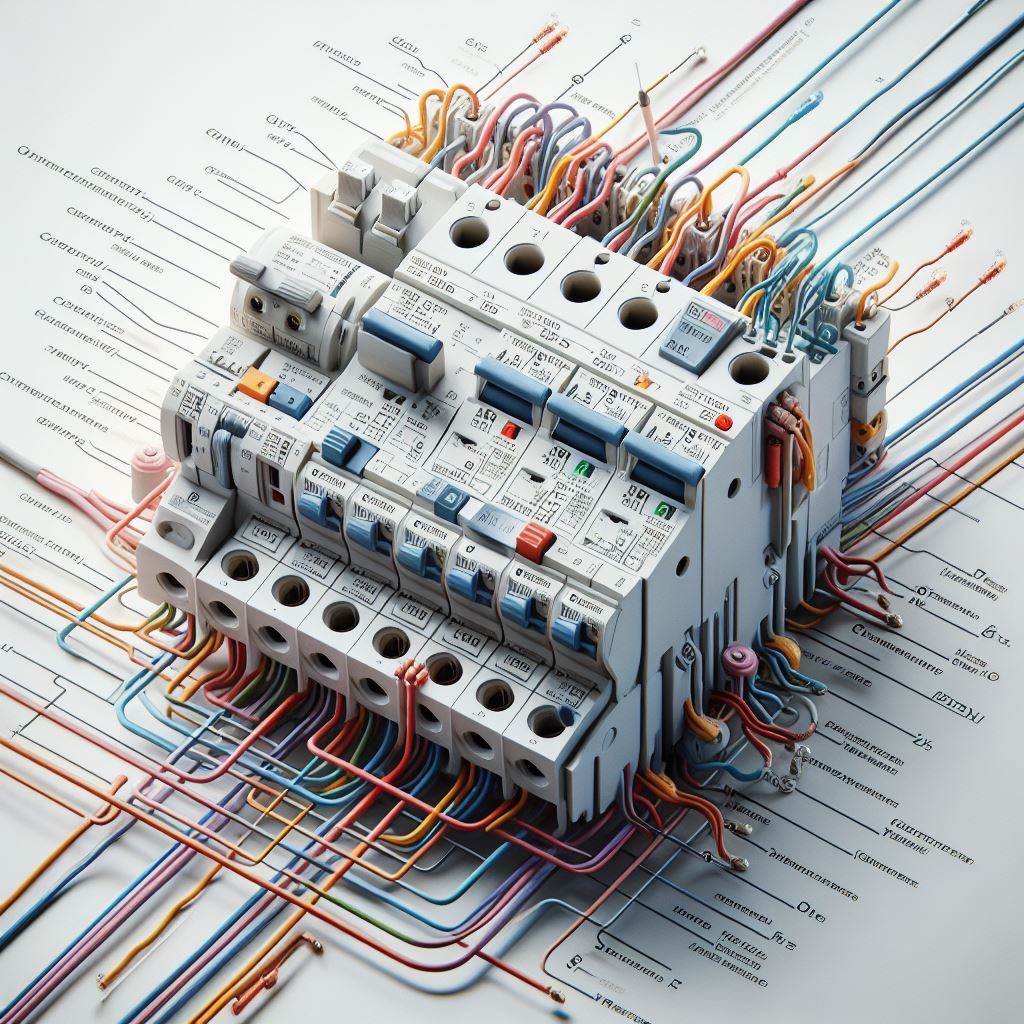
Selecting the appropriate capacity circuit breaker is crucial for ensuring the safety and efficiency of electrical wiring systems. Circuit breakers act as vital components in safeguarding electrical circuits against overloads and short circuits. Choosing the right capacity breaker requires an understanding of electrical loads, circuit characteristics, and safety standards. In this guide, we will delve into the factors to consider when selecting the correct capacity circuit breaker for your electrical wiring needs.
Understanding Electrical Loads:
Before selecting a circuit breaker, it’s essential to assess the electrical loads that will be connected to the circuit. This includes determining the total power demand of the devices and appliances connected to the circuit. The electrical load is typically measured in watts (W) or kilowatts (kW). By understanding the electrical load, you can choose a circuit breaker with an appropriate amperage rating to handle the expected current flow without tripping unnecessarily or posing safety risks.

Calculating Current Demand:
Once you have determined the electrical load, you can calculate the current demand using Ohm’s Law (I = P/V), where I is the current in amperes (A), P is the power in watts (W), and V is the voltage in volts (V). This calculation will help you identify the maximum current that the circuit will draw under normal operating conditions.
Consider Voltage and Frequency:
In addition to current demand, it’s crucial to consider the voltage and frequency of the electrical supply. Circuit breakers are designed to operate within specific voltage and frequency ranges. Ensure that the selected circuit breaker is compatible with the voltage and frequency of your electrical system to prevent malfunctions or safety hazards.
Understanding Circuit Characteristics:
Different circuits have unique characteristics that influence the selection of circuit breakers. For instance, circuits powering motors or other inductive loads may experience higher inrush currents during startup. In such cases, selecting a circuit breaker with a higher instantaneous trip rating can help accommodate these temporary surges without tripping unnecessarily.
Choosing the Right Capacity:
Once you have assessed the electrical load, current demand, voltage, frequency, and circuit characteristics, you can select the appropriate capacity circuit breaker. Circuit breakers are typically rated in amperes (A), which represents the maximum current they can safely handle without tripping.
It’s essential to choose a circuit breaker with a rating slightly higher than the calculated current demand to provide a margin of safety. However, selecting a breaker with too high a rating can compromise safety and lead to overheating or damage to electrical components. Strike a balance between adequate protection and avoiding over-sizing.
Consideration for Future Expansion:
When selecting a circuit breaker, it’s prudent to consider future expansion or changes in electrical load. Opting for a slightly higher capacity breaker than the current requirements can accommodate potential future upgrades without the need for immediate replacements. However, avoid oversizing excessively, as it may lead to inefficient operation and increased costs.
Compliance with Safety Standards:
Ensure that the selected circuit breaker complies with relevant safety standards and regulations. In many regions, electrical installations must adhere to specific codes and standards to ensure safety and reliability. Choosing certified circuit breakers from reputable manufacturers can provide assurance of quality and compliance with regulatory requirements.
Consultation with Professionals:
If you’re unsure about selecting the right capacity circuit breaker or assessing electrical loads, consider consulting with qualified electricians or engineers. They can provide expert guidance based on your specific requirements and ensure that the chosen circuit breaker meets safety standards and regulatory requirements.
Regular Maintenance and Inspection:
Once the circuit breaker is installed, ensure regular maintenance and inspection to detect any signs of wear, damage, or malfunction. Periodic testing and maintenance help ensure the continued reliability and safety of the electrical wiring system.
Conclusion:
Selecting the right capacity circuit breaker is essential for maintaining the safety and efficiency of electrical wiring systems. By understanding electrical loads, calculating current demand, considering circuit characteristics, and complying with safety standards, you can choose a circuit breaker that provides adequate protection while accommodating future needs. Consulting with professionals and performing regular maintenance are also crucial aspects of ensuring the reliability and safety of electrical installations.
A Comprehensive Guide to Selecting the Right Capacity Circuit Breaker for Electrical Wiring
Introduction:
Selecting the appropriate capacity circuit breaker is crucial for ensuring the safety and efficiency of electrical wiring systems. Circuit breakers act as vital components in safeguarding electrical circuits against overloads and short circuits. Choosing the right capacity breaker requires an understanding of electrical loads, circuit characteristics, and safety standards. In this guide, we will delve into the factors to consider when selecting the correct capacity circuit breaker for your electrical wiring needs.
Understanding Electrical Loads:
Before selecting a circuit breaker, it’s essential to assess the electrical loads that will be connected to the circuit. This includes determining the total power demand of the devices and appliances connected to the circuit. The electrical load is typically measured in watts (W) or kilowatts (kW). By understanding the electrical load, you can choose a circuit breaker with an appropriate amperage rating to handle the expected current flow without tripping unnecessarily or posing safety risks.
Calculating Current Demand:
Once you have determined the electrical load, you can calculate the current demand using Ohm’s Law (I = P/V), where I is the current in amperes (A), P is the power in watts (W), and V is the voltage in volts (V). This calculation will help you identify the maximum current that the circuit will draw under normal operating conditions.
Consider Voltage and Frequency:
In addition to current demand, it’s crucial to consider the voltage and frequency of the electrical supply. Circuit breakers are designed to operate within specific voltage and frequency ranges. Ensure that the selected circuit breaker is compatible with the voltage and frequency of your electrical system to prevent malfunctions or safety hazards.
Understanding Circuit Characteristics:
Different circuits have unique characteristics that influence the selection of circuit breakers. For instance, circuits powering motors or other inductive loads may experience higher inrush currents during startup. In such cases, selecting a circuit breaker with a higher instantaneous trip rating can help accommodate these temporary surges without tripping unnecessarily.
Choosing the Right Capacity:
Once you have assessed the electrical load, current demand, voltage, frequency, and circuit characteristics, you can select the appropriate capacity circuit breaker. Circuit breakers are typically rated in amperes (A), which represents the maximum current they can safely handle without tripping.
It’s essential to choose a circuit breaker with a rating slightly higher than the calculated current demand to provide a margin of safety. However, selecting a breaker with too high a rating can compromise safety and lead to overheating or damage to electrical components. Strike a balance between adequate protection and avoiding over-sizing.
Consideration for Future Expansion:
When selecting a circuit breaker, it’s prudent to consider future expansion or changes in electrical load. Opting for a slightly higher capacity breaker than the current requirements can accommodate potential future upgrades without the need for immediate replacements. However, avoid oversizing excessively, as it may lead to inefficient operation and increased costs.
Compliance with Safety Standards:
Ensure that the selected circuit breaker complies with relevant safety standards and regulations. In many regions, electrical installations must adhere to specific codes and standards to ensure safety and reliability. Choosing certified circuit breakers from reputable manufacturers can provide assurance of quality and compliance with regulatory requirements.
Consultation with Professionals:
If you’re unsure about selecting the right capacity circuit breaker or assessing electrical loads, consider consulting with qualified electricians or engineers. They can provide expert guidance based on your specific requirements and ensure that the chosen circuit breaker meets safety standards and regulatory requirements.
Regular Maintenance and Inspection:
Once the circuit breaker is installed, ensure regular maintenance and inspection to detect any signs of wear, damage, or malfunction. Periodic testing and maintenance help ensure the continued reliability and safety of the electrical wiring system.
Conclusion:
Selecting the right capacity circuit breaker is essential for maintaining the safety and efficiency of electrical wiring systems. By understanding electrical loads, calculating current demand, considering circuit characteristics, and complying with safety standards, you can choose a circuit breaker that provides adequate protection while accommodating future needs. Consulting with professionals and performing regular maintenance are also crucial aspects of ensuring the reliability and safety of electrical installations.



